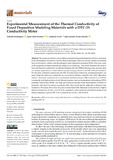Mostrar el registro sencillo del ítem
Experimental measurement of the thermal conductivity of fused deposition modeling materials with a DTC-25 conductivity meter
| dc.creator | Rodríguez García, Antonio | es_ES |
| dc.creator | Fuertes Bonel, Juan Pablo | es_ES |
| dc.creator | Oval Trujillo, Añaterve | es_ES |
| dc.creator | Pérez Artieda, Miren Gurutze | es_ES |
| dc.date.accessioned | 2024-01-30T14:53:01Z | |
| dc.date.available | 2024-01-30T14:53:01Z | |
| dc.date.issued | 2023 | |
| dc.identifier.citation | Rodriguez, A., Fuertes, J. P., Oval, A., Perez-Artieda, G. (2023) Experimental measurement of the thermal conductivity of fused deposition modeling materials with a DTC-25 conductivity meter. Materials, 16(23), 1-13. https://doi.org/10.3390/ma16237384. | en |
| dc.identifier.issn | 1996-1944 | |
| dc.identifier.uri | https://hdl.handle.net/2454/47256 | |
| dc.description.abstract | The expansion and low cost of additive manufacturing technologies have led to a revolution in the development of materials used by these technologies. There are several varieties of materials that can be used in additive manufacturing by fused deposition modeling (FDM). However, some of the properties of these materials are unknown or confusing. This article addresses the need to know the thermal conductivity in different filaments that this FDM technology uses, because there are multiple applications for these additive manufacturing products in the field of thermal insulation. For the study of thermal conductivity, the DTC-25 commercial conductivity measurement bench was used, where the tests were carried out on a set of seven different materials with 100% fabrication density—from base materials such as acrylonitrile butadiene styrene (ABS) or polylactic acid (PLA), to materials with high mechanical and thermal resistance such as thermoplastic polyurethane (TPU), polyether ether ketone (PEEK), and high-performance polyetherimide thermoplastic (ULTEM), to materials with metal inclusions (aluminum 6061) that would later be subjected to thermal after-treatments. This study shows how the parts manufactured with aluminum inclusions have a higher thermal conductivity, at 0.40 ± 0.05 W/m·K, compared to other materials with high mechanical and thermal resistance, such as TPU, with a conductivity of 0.26 ± 0.05 W/m·K. | en |
| dc.description.sponsorship | This research received external funding from the Department of Economic and Business Development of Navarre Government through R&D projects in 2020 under the research project acronym FORM3D (file codes: 0011-1365-2020-000084 and 0011-1365-2020-000127). | en |
| dc.format.mimetype | application/pdf | en |
| dc.language.iso | eng | en |
| dc.publisher | MDPI | en |
| dc.relation.ispartof | Materials 2023, 16(23), 7384 | en |
| dc.rights | © 2023 by the authors. Licensee MDPI, Basel, Switzerland. This article is an open access article distributed under the terms and conditions of the Creative Commons Attribution (CC BY) license. | en |
| dc.rights.uri | http://creativecommons.org/licenses/by/4.0/ | |
| dc.subject | Additive manufacturing | en |
| dc.subject | Fused deposition modeling | en |
| dc.subject | Filament | en |
| dc.subject | Thermal conductivity | en |
| dc.subject | 3D printing | en |
| dc.subject | DTC-25 | en |
| dc.title | Experimental measurement of the thermal conductivity of fused deposition modeling materials with a DTC-25 conductivity meter | en |
| dc.type | Artículo / Artikulua | es |
| dc.type | info:eu-repo/semantics/article | en |
| dc.date.updated | 2024-01-30T14:39:33Z | |
| dc.contributor.department | Ingeniería | es_ES |
| dc.contributor.department | Ingeniaritza | eu |
| dc.rights.accessRights | Acceso abierto / Sarbide irekia | es |
| dc.rights.accessRights | info:eu-repo/semantics/openAccess | en |
| dc.identifier.doi | 10.3390/ma16237384 | |
| dc.relation.projectID | info:eu-repo/grantAgreement/Gobierno de Navarra//0011-1365-2020-000084 | en |
| dc.relation.projectID | info:eu-repo/grantAgreement/Gobierno de Navarra//0011-1365-2020-000127 | en |
| dc.relation.publisherversion | https://doi.org/10.3390/ma16237384 | |
| dc.type.version | Versión publicada / Argitaratu den bertsioa | es |
| dc.type.version | info:eu-repo/semantics/publishedVersion | en |



